Influence of Measurement Methodologies for the Volumetric Air Flow Rate of Mobile Positive Pressure Fans on Drive Unit Performance
Abstract
:1. Introduction
2. Materials and Methods
3. Results and Discussion
4. Conclusions
Author Contributions
Funding
Institutional Review Board Statement
Informed Consent Statement
Data Availability Statement
Conflicts of Interest
References
- Kamińska, M.; Rymaniak, Ł.; Lijewski, P.; Szymlet, N.; Daszkiewicz, P.; Grzeszczyk, R. Investigations of Exhaust Emissions from Rail Machinery during Track Maintenance Operations. Energies 2021, 14, 3141. [Google Scholar] [CrossRef]
- Lijewski, P.; Szymlet, N.; Fuć, P.; Domowicz, A.; Rymaniak, Ł. The effect of start-stop systems on scooter exhaust emissions. Transp. Res. Part D Transp. Environ. 2021, 91, 102684. [Google Scholar] [CrossRef]
- Lijewski, P.; Merkisz, J.; Fuć, P. Research of exhaust emissions from a harvester diesel engine with the use of portable emission measurement system. Croat. J. For. Eng. 2013, 34, 113–122. [Google Scholar]
- Ohliger, T. Air Pollution and Noise. Factsheet on the European Union. 2017. Available online: http://www.europarl.europa.eu/atyourservice/pl/displayFtu.html?ftuId=FTU_5.4.5.html (accessed on 1 January 2018).
- Wang, D.; Liao, B.; Zheng, J.; Huang, G.; Hua, Z.; Gu, C.; Xu, P. Development of regulations, codes and standards on composite tanks for on-board gaseous hydrogen storage. Int. J. Hydrogen Energy 2019, 44, 22643–22653. [Google Scholar] [CrossRef]
- Eremina, T.; Nesterov, M.; Korolchenko, D.; Giletich, A. Problematic issues of quality, certification and tests of fire-fighting technical production. E3S Web Conf. 2020, 164, 14023. [Google Scholar] [CrossRef]
- Wei, D.; Li, S.; Wu, X.; Song, Y.; Tan, R. Design of electromagnetic compatibility test platform for transformer fire-fighting nitrogen injection extinguishing system. IOP Conf. Ser. Earth Environ. Sci. 2021, 687, 012121. [Google Scholar] [CrossRef]
- Kumm, M.; Bergqvist, A. Fire and rescue operations during construction of tunnels. In Proceedings of the ISTSS-Fourth International Symposium on Tunnel Safety and Security, Frankfurt am Main, Germany, 17–19 March 2010; pp. 383–394. [Google Scholar]
- Arca, V.J. Use of Positive Pressure Ventilation (PPV) Fans to Reduce the Hazards of Entering Chemically Contaminated Buildings; Edgewood Chemical Biological Center Aberdeen Proving Ground Md.: Washington, DC, USA, 2000. [Google Scholar]
- Lambert, K.; Welch, S.; Merci, B. The use of positive pressure ventilation fans during firefighting operations in underground stations: An experimental study. Fire Technol. 2018, 54, 625–647. [Google Scholar] [CrossRef] [Green Version]
- Li, M.; Gao, Z.; Ji, J.; Li, K. Modeling of positive pressure ventilation to prevent smoke spreading in sprinklered high-rise buildings. Fire Saf. J. 2018, 95, 87–100. [Google Scholar] [CrossRef]
- Mahalingam, A.; Patel, M.K.; Galea, E.R. Simulation of the flow induced by positive pressure ventilation fan under wind driven conditions. In Proceedings of the 12th International Fire Science & Engineering Conference, Interflam 2010, Nottingham, UK, 5–7 July 2010; Volume 1, pp. 913–924, ISBN 0955654874. [Google Scholar]
- Kerber, S.; Walton, W.D. Characterizing Positive Pressure Ventilation Using Computational Fluid Dynamics; US Department of Commerce, National Institute of Standards and Technology: Gaithersburg, MD, USA, 2003. [Google Scholar]
- Ezekoye, O.A.; Svensson, S.; Nicks, R. Investigating positive pressure ventilation. In Proceedings of the 11th International Fire Science and Engineering Conference (Interflam’07), London, UK, 3–5 September 2007. [Google Scholar]
- Panindre, P.; Mousavi, N.S.; Kumar, S. Improvement of Positive Pressure Ventilation by optimizing stairwell door opening area. Fire Saf. J. 2017, 92, 195–198. [Google Scholar] [CrossRef]
- Kaczmarzyk, P.; Klapsa, W.; Janik, P.; Krawiec, P. Identification and Evaluation of Technical and Operational Parameters of Mobile Positive Pressure Ventilation Fans Used during Rescue Operations. Saf. Fire Technol. 2021, 58, 74–91. [Google Scholar] [CrossRef]
- PN-EN 5801:2017-12; Wentylatory—Badanie Właściwości Użytkowych z Zastosowaniem Stanowisk znormalizowanych. Polski Komitet Normalizacyjny: Warszawa, Poland, 2017.
- ANSI/AMCA Standard 240-15; Laboratory Methods of Testing Positive Pressure Ventilators for Aerodynamic Performance Raing. AMCA: Arlington Heights, IL, USA, 2015.
- Fritsche, M.; Epple, P.; Delgado, A. Development of a Measurement Method for the Classification and Performance Evaluation of Positive Pressure Ventilation (PPV) Fans. In Proceedings of the Conference: ASME 2018 5th Joint US-European Fluids Engineering Division Summer Meetin, Montreal, QC, Canada, 15–18 July 2008. [Google Scholar] [CrossRef]
- Available online: https://www.fogo.pl/ (accessed on 1 January 2022).
- Available online: https://www.ramfan.com/ (accessed on 1 January 2022).
- Regulation (EU). On Requirements for Emission Limit Values of Gaseous and Particulate Pollutants and Type-approval with Respect to Internal Combustion Engines for Mobile Machines Non-road, Amending Regulations (EU) No 1024/2012 and (EU) No 167/2013 and Amending and Repealing Directive 97/68/WE. No 2016/1628 of the European Parliament and of the Council of 14 September 2016. Off. J. Eur. Union. 2016, 252, 53–117. [Google Scholar]
- Warguła, Ł.; Kukla, M.; Lijewski, P.; Dobrzyński, M.; Markiewicz, F. Impact of Compressed Natural Gas (CNG) Fuel Systems in Small Engine Wood Chippers on Exhaust Emissions and Fuel Consumption. Energies 2020, 13, 6709. [Google Scholar] [CrossRef]
- ISO 3966. Measurement of Fluid Flow in Closed Conduits—Velocity Area Method Using Pitot Static Tubes. Available online: http://driso.ir/standards/bs/BS_1042_2_4_1989_,_Measurement_of.pdf (accessed on 1 January 2022).
- Cimolino, U.; Emrich, C.; Svensson, S. Taktische Ventilation: Be-Und Entlüftungssysteme im Einsatz; Ecomed-Storck GmbH: Hamburg, Germany, 2012. [Google Scholar]
- Warguła, Ł.; Kukla, M.; Wieczorek, B.; Krawiec, P. Energy consumption of the wood size reduction processes with employment of a low-power machines with various cutting mechanisms. Renew. Energy 2022, 181, 630–639. [Google Scholar] [CrossRef]
- Kukla, M.; Wieczorek, B.; Warguła, Ł.; Górecki, J.; Giedrowicz, M. An Analytical Modelling of Demand for Driving Torque of a Wheelchair with Electromechanical Drive. Energies 2021, 14, 7315. [Google Scholar] [CrossRef]
- Rymaniak, Ł.; Lijewski, P.; Kamińska, M.; Fuć, P.; Kurc, B.; Siedlecki, M.; Kalociński, T.; Jagielski, A. The role of real power output from farm tractor engines in determining their environmental performance in actual operating conditions. Comput. Electron. Agric. 2020, 173, 105405. [Google Scholar] [CrossRef]
- Lijewski, P.; Fuc, P.; Dobrzynski, M.; Markiewicz, F. Exhaust emissions from small engines in handheld devices. In MATEC Web of Conferences; EDP Sciences: Les Ulis, France, 2017; Volume 118, p. 00016. [Google Scholar]
- Bleier, F.P. Fan Handbook: Selection, Application, and Design; McGraw-Hill: New York, NY, USA, 2018. [Google Scholar]
- Warguła, Ł.; Lijewski, P.; Kukla, M. Influence of non-commercial fuel supply systems on small engine SI exhaust emissions in relation to European approval regulations. Environ. Sci. Pollut. Res. 2022, 1–16. [Google Scholar] [CrossRef]
- Waluś, K.J.; Warguła, Ł.; Krawiec, P.; Adamiec, J.M. Legal regulations of restrictions of air pollution made by non-road mobile machinery—The case study for Europe: A review. Environ. Sci. Pollut. Res. 2018, 25, 3243–3259. [Google Scholar] [CrossRef] [PubMed] [Green Version]
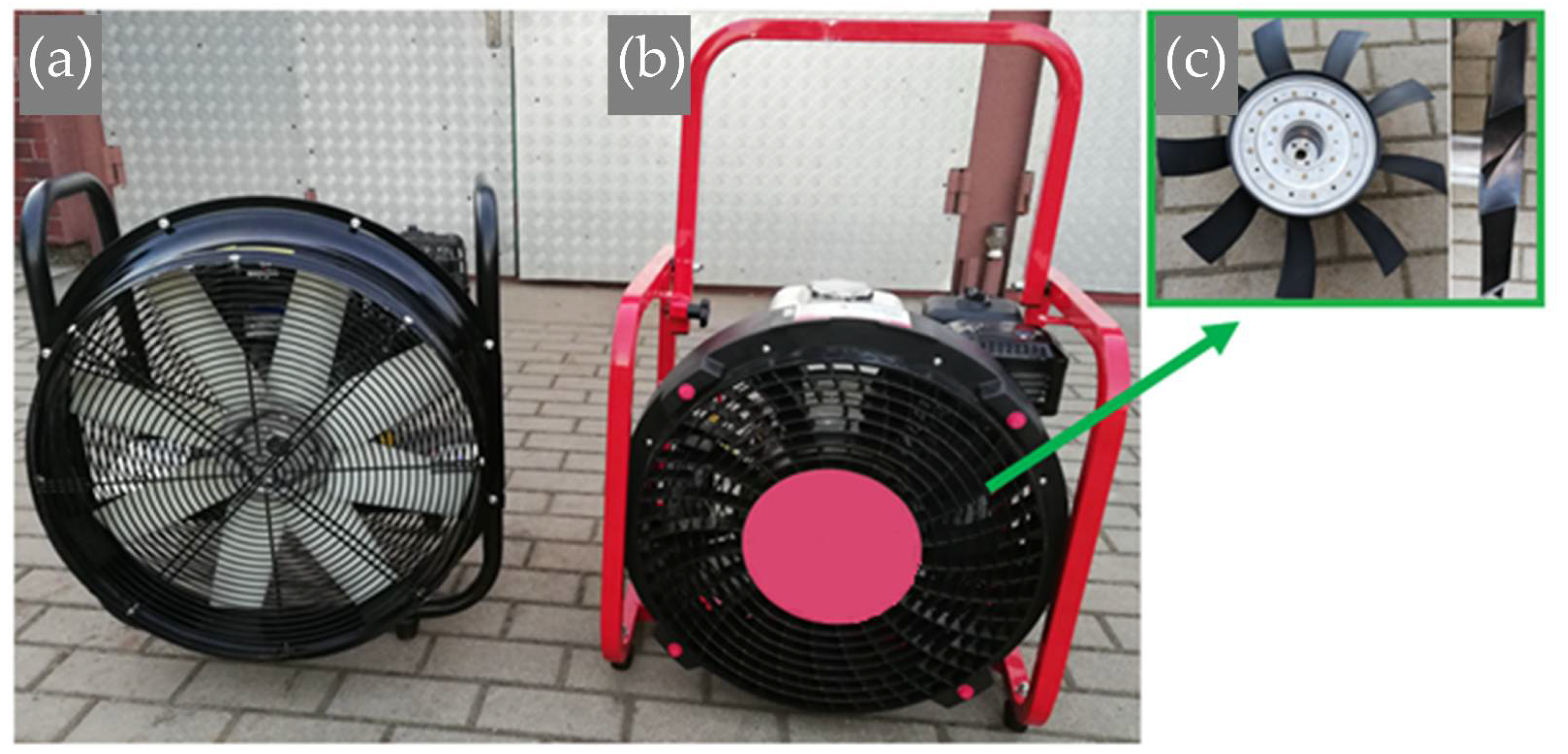
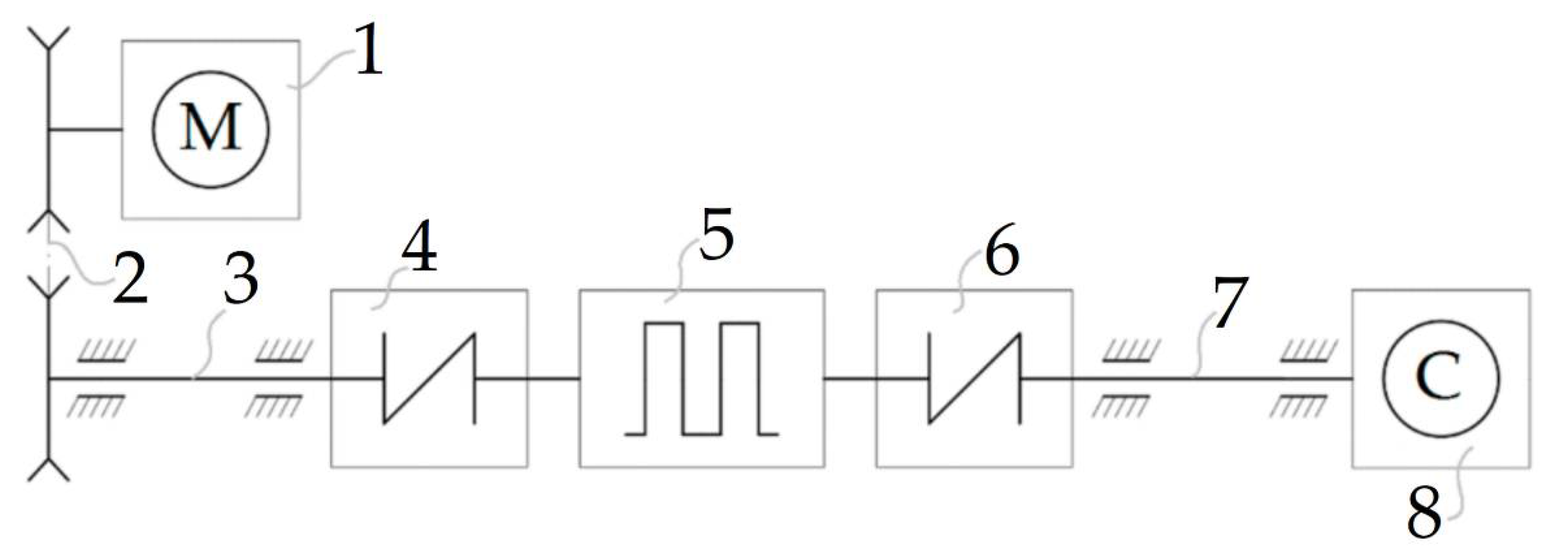
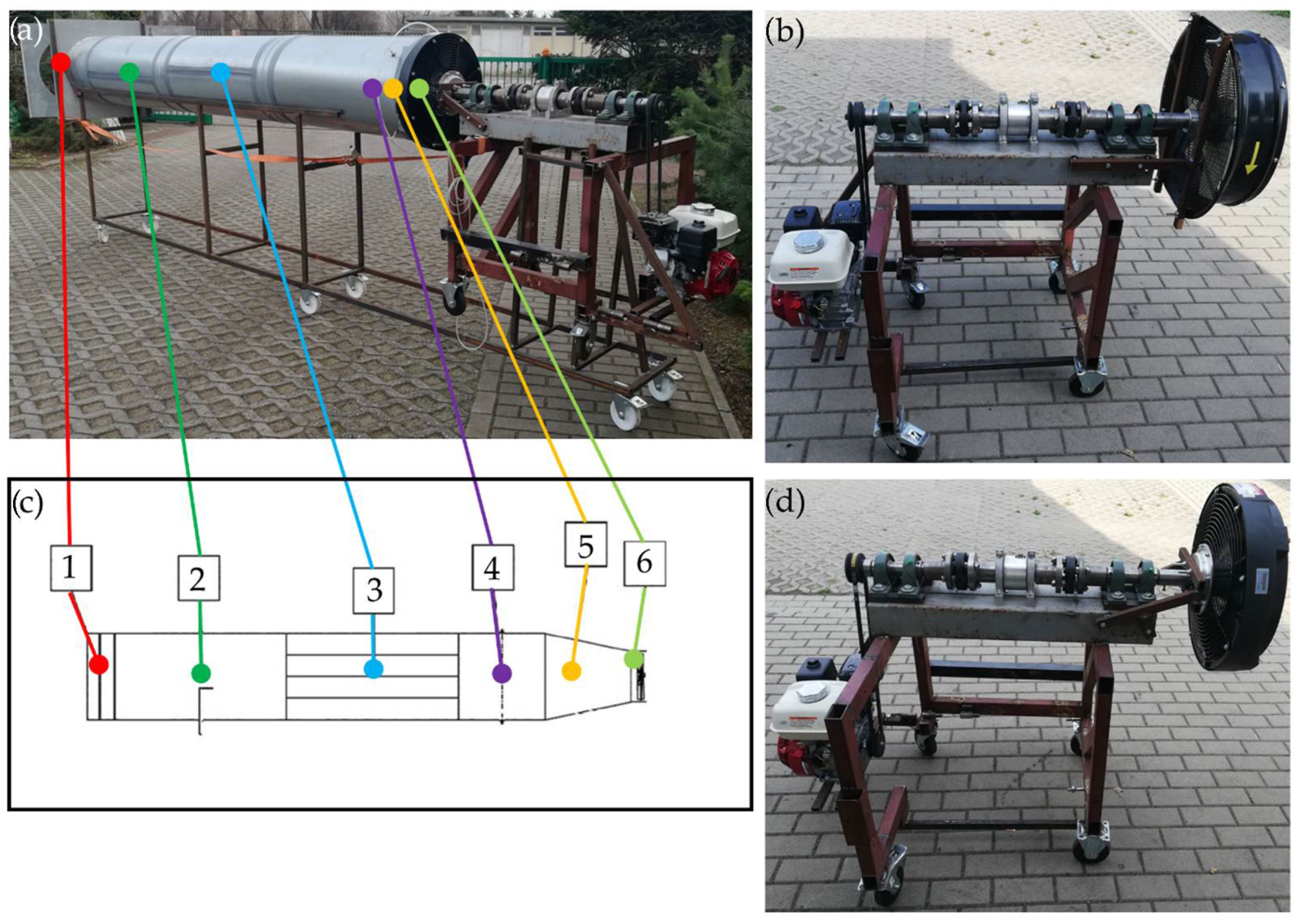

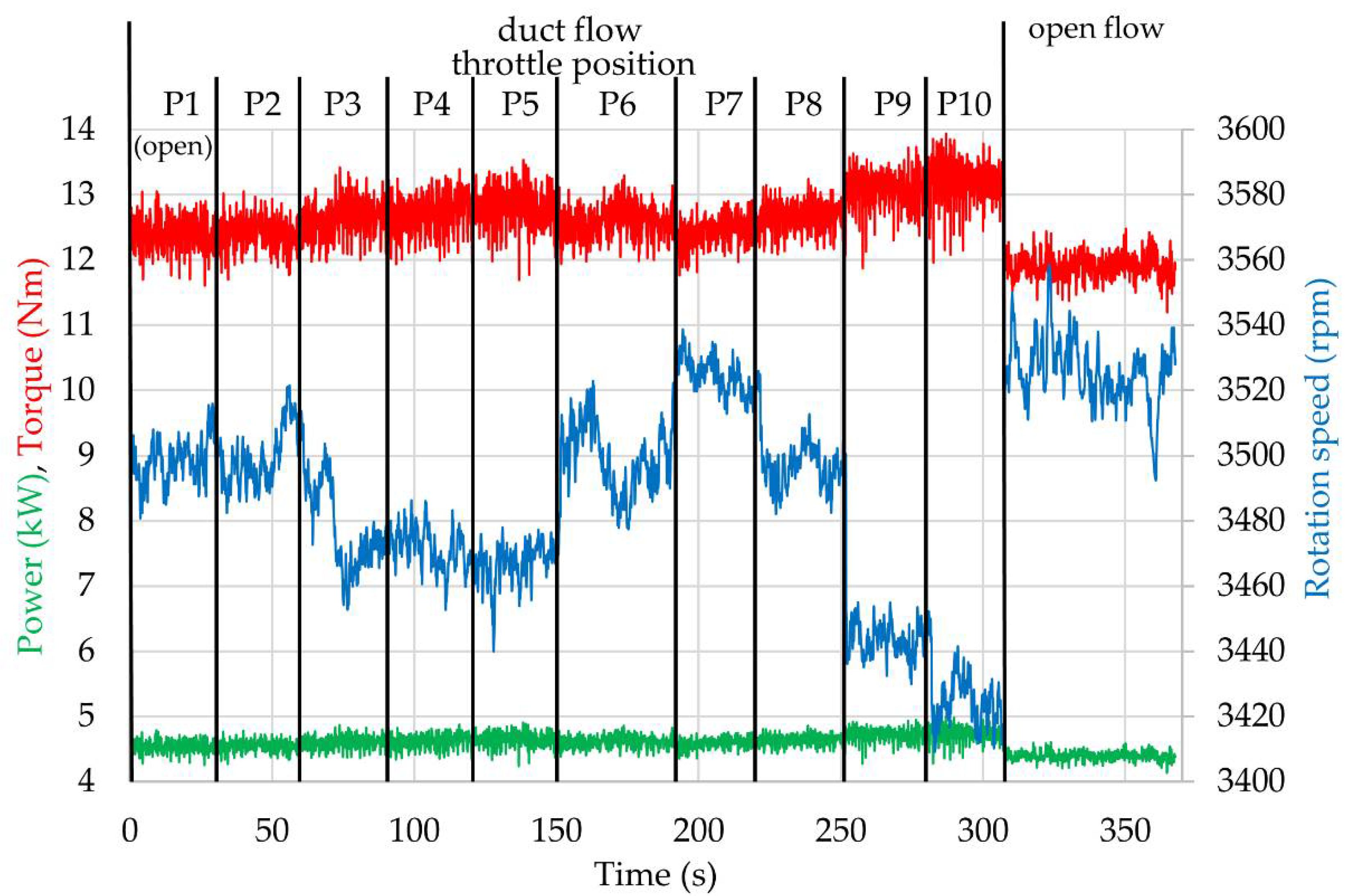
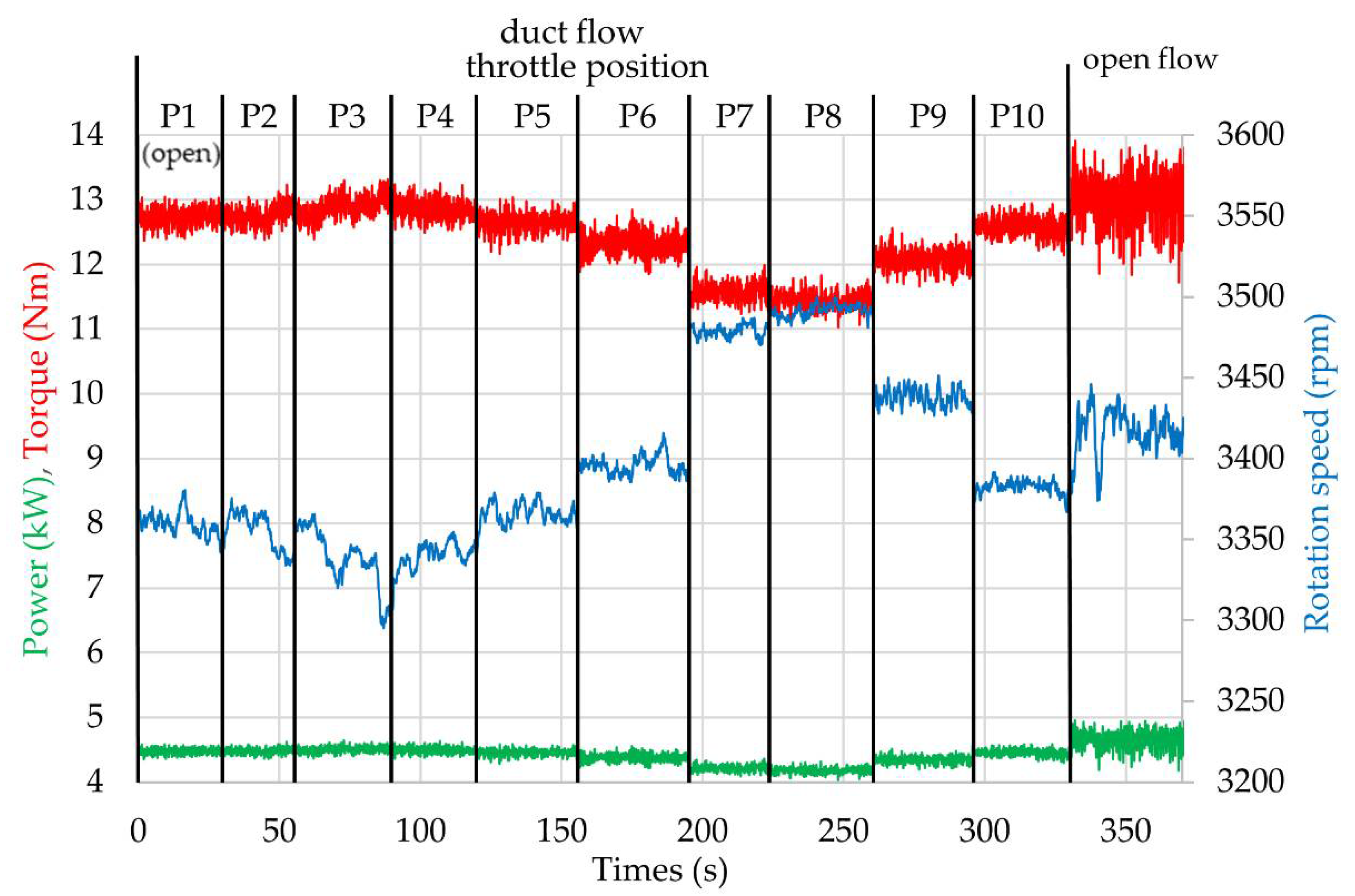



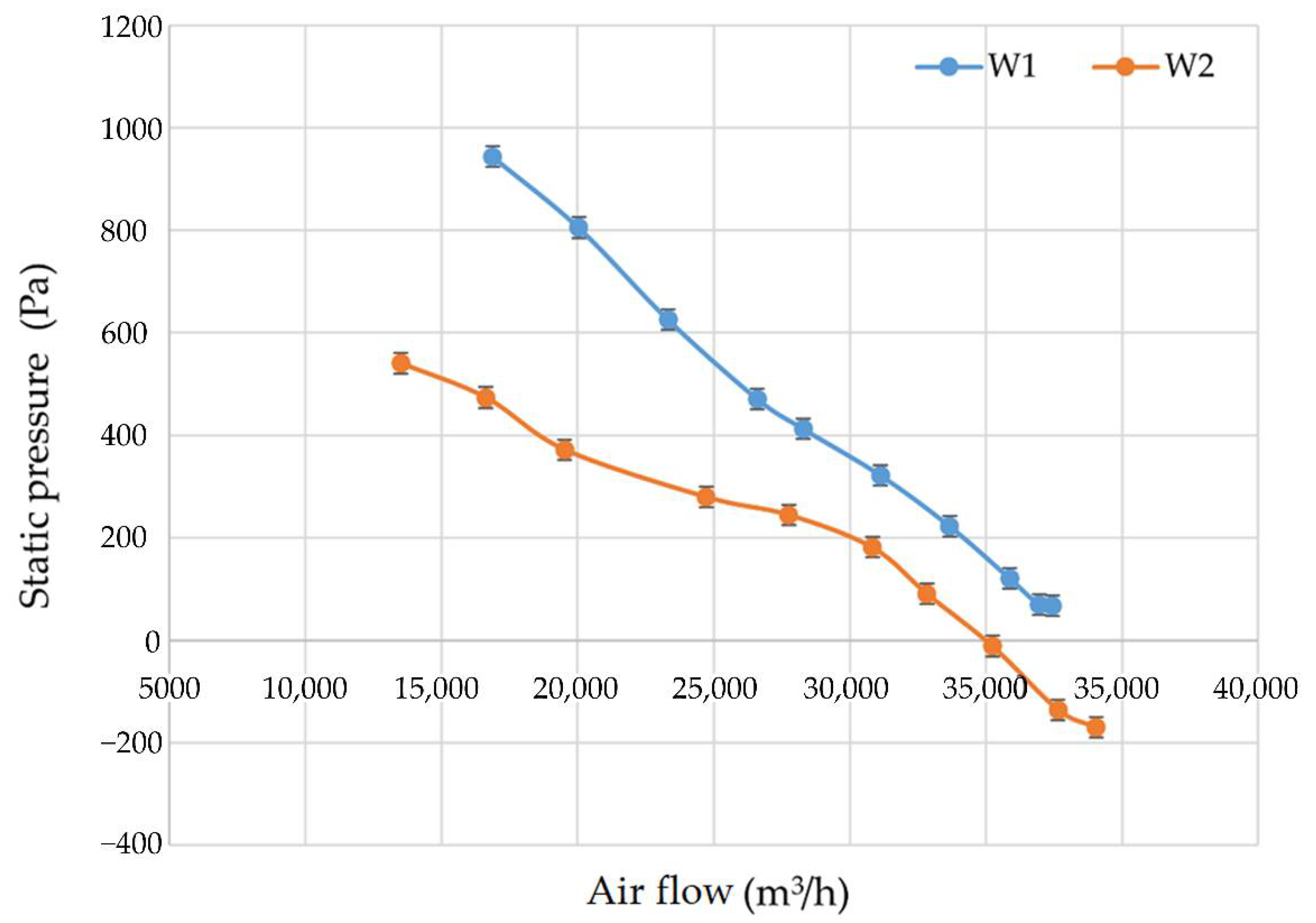
| Fan with Conventional Impeller Type (W1) | |
| Type | |
| Combustion engine | Briggs and Stratton 750 |
| Max. fan performance (AMCA 240-15) | 30,000 m3/h |
| Max. motor power at 3600 rpm | 4.4 kW |
| Displacement capacity | 163 cm3 |
| Fan with a turbo impeller (W2) | |
| Type | |
| Combustion engine | Honda GX 200 |
| Max. fan performance (AMCA 240-15) | 31,799 m3/h |
| Max. motor power at 3600 rpm | 4.1 kW |
| Displacement capacity | 196 cm3 |
| Position of the Flow Throttling Section | P1 | P2 | P3 | P4 | P5 | P6 | P7 | P8 | P9 | P10 |
|---|---|---|---|---|---|---|---|---|---|---|
| Surface area, mm2 | 173,994 | 160,576 | 147,703 | 134,919 | 122,270 | 112,054 | 97,568 | 74,005 | 52,054 | 32,303 |
| Reduction of the outlet area, % | - | 7.1 | 15.1 | 22.4 | 29.7 | 35.5 | 43.5 | 57.5 | 70 | 81.4 |
Publisher’s Note: MDPI stays neutral with regard to jurisdictional claims in published maps and institutional affiliations. |
© 2022 by the authors. Licensee MDPI, Basel, Switzerland. This article is an open access article distributed under the terms and conditions of the Creative Commons Attribution (CC BY) license (https://creativecommons.org/licenses/by/4.0/).
Share and Cite
Kaczmarzyk, P.; Warguła, Ł.; Janik, P.; Krawiec, P. Influence of Measurement Methodologies for the Volumetric Air Flow Rate of Mobile Positive Pressure Fans on Drive Unit Performance. Energies 2022, 15, 3953. https://doi.org/10.3390/en15113953
Kaczmarzyk P, Warguła Ł, Janik P, Krawiec P. Influence of Measurement Methodologies for the Volumetric Air Flow Rate of Mobile Positive Pressure Fans on Drive Unit Performance. Energies. 2022; 15(11):3953. https://doi.org/10.3390/en15113953
Chicago/Turabian StyleKaczmarzyk, Piotr, Łukasz Warguła, Paweł Janik, and Piotr Krawiec. 2022. "Influence of Measurement Methodologies for the Volumetric Air Flow Rate of Mobile Positive Pressure Fans on Drive Unit Performance" Energies 15, no. 11: 3953. https://doi.org/10.3390/en15113953
APA StyleKaczmarzyk, P., Warguła, Ł., Janik, P., & Krawiec, P. (2022). Influence of Measurement Methodologies for the Volumetric Air Flow Rate of Mobile Positive Pressure Fans on Drive Unit Performance. Energies, 15(11), 3953. https://doi.org/10.3390/en15113953







